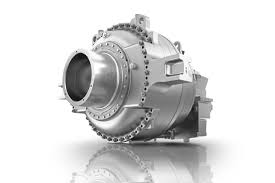 Gearboxes are a critical component in a wind turbine, helping to convert rotational energy into electrical power to drive the energy transition across the world. According to the Global Wind Gearbox Supply Chain Update 2019 published by the Global Wind Energy Council (GWEC) Market Intelligence service in December 2019, the market for the gearbox supply chain is set to grow as more wind turbines are installed in new markets for both onshore and offshore wind, and since more renewable energy systems must be installed to decarbonise the global energy system.
Gearboxes are a critical component in a wind turbine, helping to convert rotational energy into electrical power to drive the energy transition across the world. According to the Global Wind Gearbox Supply Chain Update 2019 published by the Global Wind Energy Council (GWEC) Market Intelligence service in December 2019, the market for the gearbox supply chain is set to grow as more wind turbines are installed in new markets for both onshore and offshore wind, and since more renewable energy systems must be installed to decarbonise the global energy system.By Feng Zhao, Strategy Director at Global Wind Energy Council
Mirroring the historical growth of the global wind industry, the gearbox supply chain was first established in Europe, followed by the USA and Asia. Overall, GWEC Market Intelligence estimates that annual global wind gearbox demand is likely to reach 56.4GW in 2019 and then peak at 59.1GW in 2020. This growth will parallel the wider wind energy market trends, thus being primarily driven in the USA and China as both markets will experience an installation rush until 2021.
Presently, the global manufacturing capacity of the gearbox supply chain is around 75GW. Therefore, GWEC Market Intelligence does not expect any major bottlenecks in the next five years, thus sustaining the market demand for wind energy across the world and providing a buffer for further growth.
Following the trends seen in the wind turbine OEM market, the gearbox market has seen significant consolidation over the past decade. To give you an idea of this consolidation, there were nearly 50 wind gearbox suppliers identified globally in 2010, but as of today, less than 20 gearbox suppliers are active in the supply chain. This consolidation is mainly due to the contraction of the global wind market in 2011–2013 as well as the impact of market consolidation coming from turbine OEMs. Currently, the big three gearbox suppliers, NGC, ZF and Winergy, already make up three quarters of the global gearbox production capacity; therefore competition pressure for tier 2 and 3 gearbox suppliers remains significant and GWEC Market Intelligence foresees further consolidation in the near future.
In addition to market consolidation, another major trend impacting the global gearbox market is the USA–China trade war. NGC, one of the leading gearbox producers, has its production facilities in China and is a major exporter to the USA; thus, the trade war has had a negative impact on its market potential. However, its two European rivals, Winergy and ZF, have been able to leverage their global footprint to reduce the damage imposed by the US tariffs. With the potential to further increase tariffs on Chinese exports of up to 50%, NGC has been forced to review its global supply chain strategy, which was a key driver for the company to start developing a gearbox production facility in India late in 2019.
Tariffs on key components and materials needed to build wind turbines such as gearboxes threaten the potential for wind energy as they increase the cost of production and close market and investment opportunities for companies across the wind energy supply chain. This is not only dangerous to the businesses which rely on the growth of the wind industry but also to our planet as tariffs slow down investments in the sector at a time when we need to be accelerating investments to urgently scale-up renewable energy and meet our decarbonisation goals. While the top three gearbox producers have been able to mitigate the negative impacts of the USA–China trade war for now, if these protectionist policies continue, the global renewable energy supply chain may face a serious challenge to further bring down the levelised cost of electricity (LCOE), eventually slowing down the global energy transition.
With regard to the trends in wind gearbox technology, the conventional geared-drive turbine is still the clear leader, accounting for 73% of the global market share in 2018. GWEC Market Intelligence shows that it is unlikely that the direct-drive concept will replace the conventional geared drive as the mainstream drive-train solution in the near or medium term. This being said, the rise of the offshore wind industry will provide more opportunities for the direct-drive gearbox, as the global market share for this drive-train solution is expected to reach 63% in 2023.
Meanwhile, the medium-speed drive-train has been increasingly gaining popularity, with its global market share growing from 1% in 2015 to 3.7% in 2018. GWEC Market Intelligence foresees this growth trend continuing, estimating that 10% of global gearbox demand for new installations in 2023 is likely to be for medium-speed gearboxes.
Ultimately, further technological innovation will be key to drive the gearbox market to the next level. Technology developments such as increasing gearbox torque density by replacing conventional roller bearings with journal bearings, launching the modular platform and introducing digital service solutions are recent innovations that are helping turbine OEMS and asset-owner operators to bring down the LCOE, making wind energy one of the most cost-competitive energy sources globally.
Further reading
Global Wind Gearbox Supply Chain Update 2019
